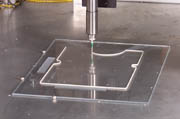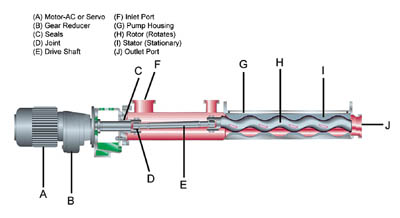



A new metering technology is available that allows for controlled dispensing of both abrasive and highly viscous materials, while being continuous duty and simple to operate. This technology is referred to as progressive cavity (PC) pumps. Until recently, PC pumps were too large to adapt to most industrial dispensing processes. The PC pump has been redesigned to be a metering pump and downsized to be integrated with industrial automation for applying adhesives and sealants.





As with all metering pumps, a constant supply of material from an external source is required. PC pumps may be gravity fed from reservoirs as long as the viscosity and flow rate characteristics of the dispensed materials are sufficient to keep the pumps supplied with material. If gravity feed is not feasible, a variety of pressure-feed methods are available. PC pumps may be fed from cartridges, pressurized tanks and transfer pumps.
A PC pump may be used as a transfer pump to supply material to another smaller PC metering pump used at the point of dispense. PC transfer pumps are available in 5-, 30- and 55-gal sizes. They offer the same advantages as PC metering pumps in that they provide material flow at low pressure and low shear as well as transfer highly abrasive and viscous materials.
Two PC pumps may be linked together and driven by one motor to create a fixed ratio meter, mix, and dispense system. More commonly, two PC pumps are independently controlled, allowing for ratio adjustments by increasing or decreasing the rotor rpms of one or both PC pumps; this setup is known as a variable ratio meter, mix and dispense system. The control system typically includes two AC or servo motor controllers, a PLC, and an HMI touchscreen control panel. Through the HMI, the rpms are monitored and changed as required. Control systems are available with the ability to automatically monitor and correct ratios. These require the use of gear or corialysis-type flow meters with the proper software. Pressure switches (an additional feature) are incorporated at the outlet of the material supply system and at the PC pump inlet to monitor material supply pressures to assure the PC pumps do not run dry. (See Table 3)
When considering equipment for applications requiring high flow rates and continuous bead extrusion with highly viscous or abrasive materials, PC metering pump technology is a valuable alternative to traditional metering systems.
For more information on progressive cavity pumps, contact Liquid Control; 8400 Port Jackson Ave. NW, North Canton, OH 44720; phone 330-494-1313; fax 330-494-5383; e-mail salesinfo@liquidcontrol.com ; or visit www.liquidcontrol.com.
